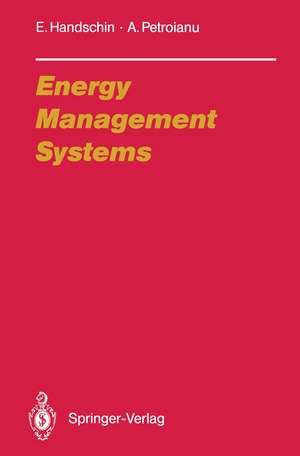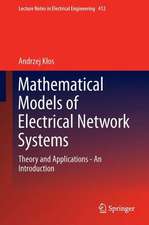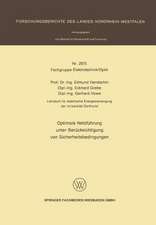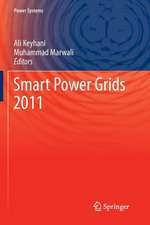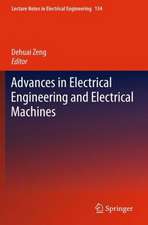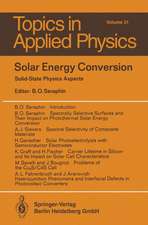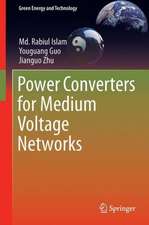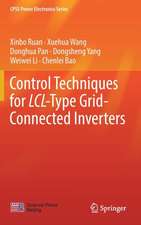Energy Management Systems: Operation and Control of Electric Energy Transmission Systems: Electric Energy Systems and Engineering Series
Autor Edmund Handschin, Alexander Petroianuen Limba Engleză Paperback – 8 dec 2011
Preț: 635.65 lei
Preț vechi: 747.82 lei
-15% Nou
Puncte Express: 953
Preț estimativ în valută:
121.64€ • 130.07$ • 101.41£
121.64€ • 130.07$ • 101.41£
Carte tipărită la comandă
Livrare economică 17 aprilie-01 mai
Preluare comenzi: 021 569.72.76
Specificații
ISBN-13: 9783642840432
ISBN-10: 3642840434
Pagini: 200
Ilustrații: XIII, 183 p.
Dimensiuni: 155 x 235 x 15 mm
Greutate: 0.29 kg
Ediția:Softcover reprint of the original 1st ed. 1991
Editura: Springer Berlin, Heidelberg
Colecția Springer
Seria Electric Energy Systems and Engineering Series
Locul publicării:Berlin, Heidelberg, Germany
ISBN-10: 3642840434
Pagini: 200
Ilustrații: XIII, 183 p.
Dimensiuni: 155 x 235 x 15 mm
Greutate: 0.29 kg
Ediția:Softcover reprint of the original 1st ed. 1991
Editura: Springer Berlin, Heidelberg
Colecția Springer
Seria Electric Energy Systems and Engineering Series
Locul publicării:Berlin, Heidelberg, Germany
Public țintă
Professional/practitionerCuprins
1 Introduction.- 1.1 Electric energy systems.- 1.2 Power system engineering.- 1.3 Evolution of power system control technology.- 1.4 Control centre justification.- 2 System engineering aspects of power system operation.- 2.1 Classification.- 2.2 Time decomposition.- 2.3 Network level decomposition.- 2.4 Mode decomposition.- 2.5 Operation state decomposition.- 2.6 Activity decomposition.- 2.7 Control decomposition.- 2.8 User oriented decomposition.- 2.9 Analysis decomposition.- 2.10 Control flow decomposition.- 3 Typical energy control centre functions.- 3.1 System monitoring and security.- 3.2 System economy.- 3.3 System control.- 3.4 Restorative control.- 4 Power system control centre: hardware structure.- 4.1 Overview.- 4.2 Remote terminal unit.- 4.3 Communication.- 4.4 The real-time computer system.- 4.5 Review of hardware structure for network control centres.- 4.6 Hardware design considerations.- 4.7 Hardware obsolescence.- 4.8 Performance of SCADA/EMS.- 5 Power system control centre: software structure.- 5.1 Overview.- 5.2 Data acquisition subsystem.- 5.3 Supervisory control subsystem.- 5.4 Real-time software environment.- 5.5 Data base management system.- 5.6 Man-machine interface.- 5.7 Inter-utility communication subsystem.- 6 Power system control centre: dispatcher’s activities.- 6.1 Introduction.- 6.2 Salient features of the operator activity.- 6.3 A conceptual model of the dispatcher’s activity.- 6.4 Requirements.- 6.5 Trends in power dispatch operator’s activity.- 7 Power system and dispatch training simulator.- 7.1 Introduction.- 7.2 Power system technological requirements.- 7.3 Functions of a training simulator.- 7.4 Modelling aspects.- 7.5 Different types of training simulators.- 7.6 Training scenarios and training sessions.- 7.7 Concludingremarks.- 8 Existing energy management systems.- 8.1 General remarks.- 8.2 Energy management systems in a US utility.- 8.3 Energy management systems in Germany.- 8.4 Energy management systems in developing countries.- 9 Project management of energy management systems.- 9.1 Overview.- 9.2 Stages in the implementation of a new control centre.- 9.3 A step-by-step plan for implementing a new control centre.- 9.4 Design, development, and maintenance of software.- 10 Expert systems for power system operation.- 10.1 Overview.- 10.2 Security monitoring and control.- 10.3 Definitions.- 10.4 Structure of the expert system.- 10.5 Possibilities and limits of expert systems.- 10.6 Applications.- 10.7 Conclusions.- References.
